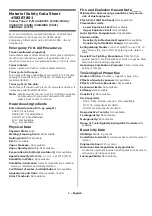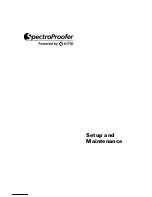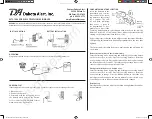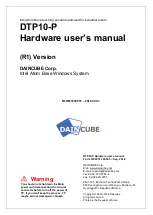
MTi and MTx User Manual and Tech. Doc., © 2005, Xsens Technologies B.V.
MT0100P.E
16
2.6
Reset of output or reference co-ordinate systems
2.6.1 Output with respect to non-default coordinate frames
In some situations it may occur that the sensor axes are not exactly aligned with the axes of
the object of which the orientation has to be recorded. It may be desired to output the
orientation and/or calibrated inertial data in an object-fixed frame, as opposed to an sensor-
fixed frame. Four features have been added to the software to facilitate in obtaining the output
in the desired coordinate frames.
1.
A heading reset that redefines the X-axis of the global coordinate frame while
maintaining the Z-axis along the vertical. After the heading reset the orientation will
be expressed with respect to the new global (earth fixed) reference frame.
2.
A global reset that permits the user to use the MTI / MTx to define all the axes of the
global coordinate frame (including Z-axis, up/down).
3.
An object reset that defines how the sensor it oriented with respect to the coordinate
axes to which it is attached. After the object reset, both the orientation and the
calibrated sensor data are expressed with respect to the axes of the object.
4.
A combined object/heading reset, referred to as alignment.
NOTE:
For all co-ordinate system reset functions it is important to remember that the housing
of the MTx can not be considered an accurate reference. Placement and subsequent aligning
must be done very carefully otherwise (alignment) errors may be induced.
2.6.2 Heading reset
Often it is important that the global Z-axis remains along the vertical (defined by local gravity
vector), but the global X-axis has to be in a particular direction. In this case a heading reset
may be used, this is also known as “bore sighting”. When performing a heading reset, the new
global reference frame is chosen such that the global X-axis points in the direction of the
sensor while keeping the global Z-axis vertical (along gravity, pointing upwards). In other
words: The new global frame has the Z axis along gravity, pointing upwards, the X-axis in the
plane spanned by the vertical and the sensor X-axis, perpendicular to the global Z-axis and the
Y-axis such that a right handed coordinate system is formed.
NOTE:
After a heading reset, the yaw may not be exactly zero, this occurs especially when
the X-axis is close to the vertical. This is caused by the definition of the yaw when using
Euler angles, which becomes unstable when the pitch approaches ± 90 deg.
2.6.3 Global reset
When performing a full “global” reset, the MTi / MTx axes (
S
) is used to define the axes of
the new global coordinate frame (
G
). When pressing the reset button or sending the reset
command,
S
has to be orientated in such a way that the sensor axes all point in exactly the
same direction as the axes of the global coordinate frame. After this the orientation output will
be with respect to the newly defined global axes.
















































